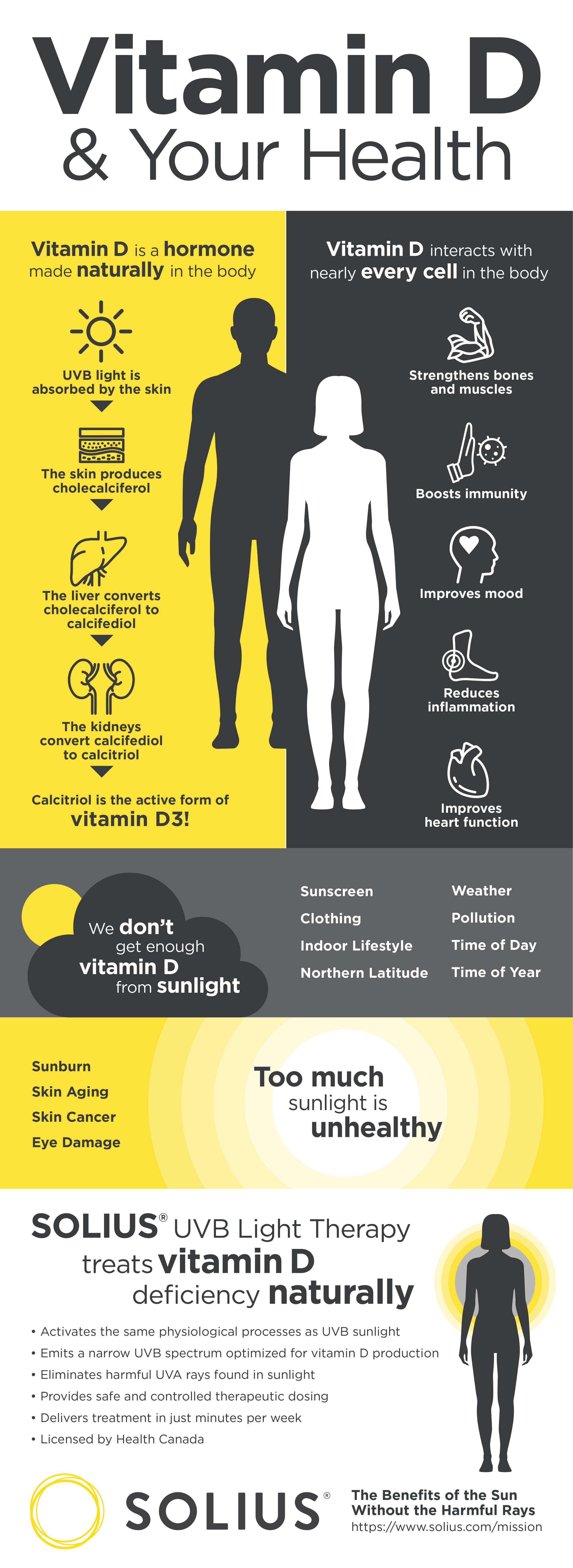The Health Benefits of Sunlight
Important Safety Information
SOLIUS devices are only intended to stimulate the production of endogenous vitamin D for the treatment and prevention of vitamin D deficiency.
Please review the intended use, indications and contraindications, and known risks associated with SOLIUS therapy. Ask your doctor if SOLIUS is right for you.
We have long used the power of sunlight to prevent infections, ward off diseases and heal illness. There is a reason we innately enjoy soaking in the sun’s rays on a beautiful day; beneficial biomolecules activate when your body is exposed to light, positively impacting both mind and body. These healthy photo-biproducts act as anti-inflammatories, vasodilators (which help reduce blood pressure), and endorphins. They keep your body strong and your mind focused.
The benefits of sunlight are well documented throughout history. Nursing pioneer Florence Nightingale observed during the Victorian era that sick patients in rooms with ample sunlight recovered more quickly compared to those in rooms with no windows. This reflection, coupled with others, laid the foundation for a modern approach to science and medicine.
The SOLIUS Newsletter
Education and Exclusive Offers
Vitamin D production is one of the most well-known health benefits activated by exposure to sunlight. For our skeletal, cardiovascular, neurological, and immune systems, maintaining proper vitamin D levels protects against disease, optimizes physical performance, and improves mental health. Keep reading to unravel the full benefits of sunlight and vitamin D – also known as the sunshine vitamin.
The Sunshine Vitamin
Vitamin D is often referred to as the sunshine vitamin because vitamin D3 production in the skin is activated by the sun’s ultraviolet B (UVB) rays. Despite being called a vitamin, vitamin D is actually a hormone produced within the body.
Vitamin D is naturally produced when UVB light is absorbed by the skin, converting a specialized cholesterol to pre-vitamin D3. Pre-vitamin D3 then converts to vitamin D3 in the skin and transfers to the bloodstream over several days. After arriving in the liver, vitamin D requires two metabolic conversions to become calcitriol – the active form of vitamin D. Calcitriol binds to vitamin D receptors in nearly every cell throughout the body.
Though it sounds complicated, this process is regulated naturally by the body. The bioavailability of vitamin D is managed by several internal control mechanisms to ensure your body gets only what it needs. When vitamin D levels are maintained, this hormone boosts your immune system — readying you for any physical or mental challenge that comes your way.
Overcoming Obstacles
Studies have shown that vitamin D insufficiency is widespread, with approximately 77% of the global population experiencing low levels of vitamin D [1,2]. Awareness of the importance of vitamin D’s role in overall health is crucial to living your healthiest life.
While spending time in the sun sounds easy, the shift from an agrarian society into today’s information age has directly affected our lifestyle — which now includes sitting behind a computer screen for hours each day. Our indoor society is exposed to the sun much less than prior generations.
When we do make time to enjoy the beauty of the outdoors, too often we cover our arms, legs and face with lightweight clothing and wide-brimmed hats. This is in large part thanks to increased awareness of sunburn and skin cancer risks, as well as to prevent premature skin aging. Such awareness has led to increased protection from the sun’s harmful UVA rays. However, these measures also block beneficial UVB rays, which has resulted in epidemic levels of vitamin D deficiency [3].
Maintaining proper levels of vitamin D is vital to overall health and wellness. Deficiency of the sunshine vitamin is correlated with more than 53 disease states, including breast cancer, multiple sclerosis, osteoporosis, and rheumatoid arthritis, as well as a host of mental health conditions.
Science Says, More Sun Please
Not yet convinced of the health benefits gained from exposure to sunlight? Just look to the science. Daily exposure to sunlight has been shown to reduce the incidence of multiple sclerosis, type 1 diabetes, hypertension, and even the occurrence and mortality from multiple forms of cancer.
A 20-year study following approximately 30,000 subjects found that those who avoided exposure to the sun were twice as likely to die from all causes [4]. This research corroborates several prior studies that stated diminished exposure to the sun is a risk factor for all-cause mortality.
A 20-year study following approximately 30,000 subjects found that those who avoided exposure to the sun were twice as likely to die from all causes.
The literature also points to the correlation between lack of sunlight and several conditions that greatly impact quality of life. This includes depression, bipolar disorder, suicidal thoughts and self-harm, as well as decreased cognitive performance. Such symptoms worsen during the winter months when natural exposure to the sun is decreased. This shift in mindset is not a coincidence.
Health Benefits of the Sun
Our skin, when exposed to sunlight, produces several hormones and peptides that contribute to our systemic health and wellness. Substances made from chemical reactions with sunlight are called photoproducts. Vitamin D3 is the most universally recognized health benefit, but it is just one of many.
Healthy photoproducts stimulated by UVB light include:
Vitamin D3
Impacts musculoskeletal, cardiovascular, neurological and immune system responsesCalcitonin Gene Related Peptide (CGRP)
Reduces hypertension and inflammation, and regulates the immune systemNeuropeptide Substance P (SP)
Promotes proper blood flow and regulates immune systemAdrenocorticotropic Hormone (ACTH)
Reduces inflammation and regulates immune systemMelanocyte Stimulating Hormone (MSH)
Reduces inflammation and increases libidoCalcitriol
Regulates cellular function and is involved in all major systems of the bodyBeta Endorphin (BE)
Increases relaxation, acts as a natural painkiller and promotes feeling of well-being
All of these substances contribute to that relaxed, happy feeling we get when we are regularly exposed to the sun. Nature reinforces sun-seeking behaviors and UVB-synthesized photoproducts collectively harmonize to keep us healthy.
How Much is Enough?
The optimal dose of vitamin D varies and is dependent on the individual. Studies demonstrate that sun exposure causing a slight pinkness of the skin within 24 hours has the potential to stimulate 15,000-20,000 IU vitamin D production in the body [5].
Trouble is, we are all busy — and it’s tough to get enough sun exposure when you factor in the variables that must align: latitude, season, time of day, cloud cover, altitude, sunscreen use, and pollution. To generate the optimal dose of vitamin D from the sun, we must expose our skin to direct sunlight when atmospheric and geographic conditions are perfect.
To Supplement or Not
To combat the winter blues and maintain healthy levels of vitamin D year-round, many turn to vitamin D supplements. However, supplements are handled differently by the body than sunlight, meaning it’s possible to ingest copious and potentially toxic levels of vitamin D from supplements. This concern does not exist when looking at natural sun exposure; if your body has enough vitamin D, it will simply produce less of it.
Research shows that while higher levels of vitamin D created by the sun are useful in preventing disease, supplements do not provide the same benefit. The discrepancy in the benefits received from sunlight-induced vitamin D versus supplemental vitamin D can be explained by one fact: the correlation between higher blood levels of vitamin D and disease prevention in epidemiological research is measuring sun exposure and not supplemental vitamin D.
Population studies have repeatedly demonstrated that sun exposure is a bigger contributor to vitamin D concentration that supplementation. Therefore, at a population level, vitamin D is a good measure of sun exposure, and higher serum concentrations are an indicator of greater skin contact with the sun’s light [6,7].
The assumption that vitamin D from supplements represents the same health benefits as vitamin D from light fails to consider the benefits of the sun outside of vitamin D production. It is important to understand there are other vital elements that contribute to our systemic health. While the contributions of each of these photoproducts continue to be unraveled by researchers, one thing is clear: humans need exposure to UVB rays for physical and mental health and wellness.
The Natural Alternative
Light therapy treatments, such as those offered by SOLIUS, are a creative and innovative way to harness the benefits of the sun without the harmful rays. SOLIUS was founded with the sole mission to make the world a healthier place, and it’s doing just that by giving us the power to unlock our natural healing powers using UVB light.
Capturing a very narrow spectrum of UVB light, coined “the life spectrum” (293nm to 303nm), SOLIUS harnesses the best attributes of the sun to activate the natural production of vitamin D. This advanced treatment virtually eliminates concerns associated with prolonged sun exposure, delivering the benefits of the sun without the harmful UVA rays.
Conclusion
Vitamin D derived from light – natural or through a UVB light therapy treatment – has a positive impact on mind and body. It is up to everyone to ensure proper levels of vitamin D are maintained to protect against disease, optimize physical performance, and improve mental health.
Sources
[1] González-Gross M, Valtuena J, Breidenassel C, et al. Vitamin D status among adolescents in Europe: the Healthy Lifestyle in Europe by Nutrition in Adolescence study. Br J Nutr. 2012;107:755-764.
[2] Ginde A, Liu M, Camargo C. Demographic differences and trends of vitamin D insufficiency in the US population, 1988-2004. Arch Intern Med. 2009;169:626-632.
[3] Matsuoka L, Ide L, Wortsman J, MacLaughlin J, Holick M. Sunscreens suppress cutaneous vitamin D3 synthesis. J Clin Endocrinol Metab. 1987;64:1165-1168
[4] Lindqvist PG, Epstein E, Landin-Olsson M, et al. Avoidance of sun exposure is a risk factor for all-cause mortality: results from the Melanoma in Southern Sweden cohort. J Intern Med. 2014;276:77-86
[5] Holick M. Vitamin D: a d-lightful solution for health. J Investig Med. 2011;59:872–880.
[6] Reusch J, Ackermann H, Badenhoop K. Cyclic changes of vitamin D and PTH are primarily regulated by solar radiation: 5-year analysis of a German (50 N) population. Horm Metab Res. 2009;41:402-407.
[7] Holick M. Sunlight and vitamin D for bone health and prevention of autoimmune diseases, cancers, and cardiovascular disease. T Am J Clin Nutr. 2004;80:1678S-88S.





